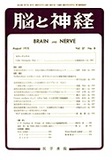Japanese
English
- 有料閲覧
- Abstract 文献概要
- 1ページ目 Look Inside
I.はじめに
脳動脈瘤破裂によつて短時間内に不可逆的脳幹障害が出現する致死的クモ膜下出血は,全破裂脳動脈瘤の10数%であると云われており,現在のところ,この様な症例に対しては救命の方法は少ないと言わざるを得ない。しかし意識障害が高度であつても,器質的不可逆的脳幹障害などをみず,他の可逆的原因によつて意識障害が発生しているものも少なくない。この様な症例に対してこそ,脳神経外科医は救命のための積極的な方法を開拓する必要があると言え,いたずらに保存的治療のみの消極的方法によつて意識レベルの上昇のみを期待して,再出血発作などによつて根治治療のチャンスを逃すべきではないと考えられる。そのためにはまず,発症早期における意識障害がどの様な原因によつて起こつているのかを把握し,対策をたてる必要があろう。現在まで発症早期における意識障害は,血腫等による一次的な脳損傷の部位と広がり,頭蓋内圧亢進,一時的又はある程度持続する脳循環障害などにより,その結果が相乗的に作用して出現するであろうと推測されている8)。そこでこれらを,現在私達が施行しうる諸検査によつて客観的に抽出することを目的にした。次に,抽出された意識障害因子間の関連図を作製し,その結果に基づいた妥当な治療方針を提示した。
Factors complicating disturbance of consciousness were analysed and some neurosurgical procedures were carried out to improve level of consciousness in 58 patients with subarachnoid hemorrhage (SAH) due to ruptured intracranial aneurysms admitted within 3 days after bleeding from January, 1972 to December, 1973.
The sites of ruptured aneurysm of this series were internal carotid artery in 21 cases, anterior communicating artery or A1 porton of anterior cerebral artery (ACA) in 18, middle cerebral artery in 13, A2 portion of ACA in 2 and teritory ofvertebral artery in 4 cases.
At admission, we had 5 deep comatose, 6 comatose, 9 semicomatose, 11 stuporous, 16 somnolent and 11 alert patients. In the various state of consciousness, the relationships between disturbance of con-sciousness and some values of clinical examinations were analysed statistically. The factors in clinical examinations were regional cerebral blood flow dynamics measured by Xe133 clearance method, cerebral circulation time, grade of ventricular en-largement and vasospasm by serial angiography, intracerebral hematom and grade of SAH by autopsy or operation, and cerebrospinal fluid pressure by lumbar puncture. Out of those factors, intracerebral hematomas were revealed in 55% of deep comatose or semicomatose patients but in 13% of stuporous or alert patients. Mortality rate of patients with intracerebral hematom were 100% in conservatively treated cases but 10% in surgically.
The values of ventriculocranial (VC) index, in which showed size of lateral ventricle, were 0.295 in comatose and O.268±0.015 in alert patients. Only by continuous ventricular drainage and exter-nal decompression, decrease of VC index and im-provement of level of consciousness were obtained simultaneously.
Cerebral blood flow (CBF) measurements were performed in 14 cases without intracerebral hematom. The values of CBF were 20.6 (ml/100g/min) in a comatose case but 45.7±13.9 (ml/100g/min) in somnolent patients.
Namely, intracerebral hematom (P<O.01), grade of ventricular dilatation (P<0.05) and cerebral blood flow decrease (P<0.02) could be extraced as factors which were significantly related to disturbance of consciousness at acute stage of SAH. Although other factors had no direct correlation with level of consciousness but indirect relation to significant factors complicating disturbance of consciousness.
To improve level of consciousness and cerebral blood flow dynamics, some neurosurgical procedures might be needed, such as evacuation of intracerebral hematom, continuous ventricular drainage and external decompression as soon as possible after onset of SAH.

Copyright © 1975, Igaku-Shoin Ltd. All rights reserved.


